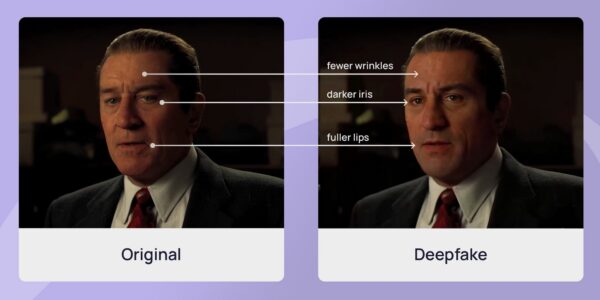Deepfake is a form of digital manipulation that uses artificial intelligence to create fraudulent videos or images. While it does not directly mimic phishing attacks, deepfakes can be used for phishing scams by impersonating someone in a video call or sending fake media to trick individuals into giving out sensitive information. Therefore, it is essential to stay vigilant and be cautious of any suspicious videos or messages, as they could potentially be a deepfake posing as a phishing attack.
Table of Contents
- What Is Deepfake Phishing?
- The Rise of Deepfake Phishing
- How to Protect Against Deepfake Phishing
- Deepfake Phishing: The Dangerous New Face Of Cybercrime
- How does deep fake phishing work?
- 1. Emails Or Messages
- 2. Video Calls
- 3. Voice Messages
- Why should Companies be concerned about deep fake phishing?
- FAQS on Deepfake Being Phishing
- Final Thoughts
What Is Deepfake Phishing?
Deepfake phishing is a cyberattack that uses artificial intelligence technology to create fake audio or video content. This content is then used to trick individuals into believing they are interacting with a legitimate source, such as their boss or a company representative. Deep fake phishing aims to obtain sensitive information, like login credentials or financial data, from the target.
These attacks are highly sophisticated and challenging to detect, threatening personal and organizational security. Individuals and organizations must be aware of this cyberattack and take necessary precautions to protect themselves against it.
The Rise of Deepfake Phishing
The rise of deep fake phishing has become a significant concern for individuals and organizations alike. This emerging cyberattack combines artificial intelligence and social engineering techniques to create compelling fake videos or audio recordings.
These deepfakes often trick victims into giving away sensitive information or transferring money to fraudulent accounts. With the increasing availability of AI technology, it has become easier for attackers to create these sophisticated scams that are difficult to detect. As a result, individuals and businesses must stay vigilant and educate themselves on how to spot and avoid falling victim to deepfake phishing attacks.
How to Protect Against Deepfake Phishing

- Be cautious of suspicious links: Always be careful when clicking on links, especially from unknown sources. Deepfake phishing attacks often use deceptive links to trick users into revealing personal information.
- Verify the sender’s email address: Check the sender’s email address carefully, as hackers may try to impersonate a legitimate source. Look out for slight variations or misspellings in the domain name.
- Use two-factor authentication: Adding an extra layer of security through two-factor authentication can help prevent unauthorized access to your accounts.
- Keep your software updated: Regularly update your operating system and security software to protect against vulnerabilities that deep fake phishing attacks can exploit.
- Educate yourself and others: Stay informed about new phishing techniques and educate others on how to spot them. Encourage friends and family to be cautious when sharing personal information online.
- Utilize anti-phishing tools: Consider using anti-phishing tools and software, such as browser extensions or email filters, to provide additional protection against deep fake phishing attacks.
Remember, being vigilant and cautious is vital in protecting yourself against deep fake phishing attempts. If you suspect you have been a victim of such an attack, alert the appropriate authorities immediately and change your passwords as a precautionary measure.
Deepfake Phishing: The Dangerous New Face Of Cybercrime
Deepfake phishing is a dangerous new form of cybercrime that uses artificial intelligence to create realistic videos or images of someone’s face and voice. These fake videos are then used to trick people into giving away sensitive information, such as passwords or financial details.
The advancements in deep fake technology have made it increasingly difficult for people to distinguish between real and fake, making it easier for cybercriminals to manipulate their victims.
This has become a growing concern as deep fake phishing attacks have increased in frequency and sophistication. Individuals and organizations must be aware of this threat and take necessary precautions to protect themselves from falling victim.
How does deep fake phishing work?

1. Emails Or Messages
Emails or messages: Deepfake phishing uses emails or messages containing fake information or instructions, often disguised as coming from a trusted source. The goal is to trick the recipient into clicking on a malicious link or providing sensitive information.
2. Video Calls
Video calls: In this type of deepfake phishing, scammers use artificial intelligence to create realistic videos of someone impersonating a trusted person, such as a CEO or government official. They may use these videos to request money transfers or sensitive information from the victim.
3. Voice Messages
Voice message: Similar to video calls, deep fake phishing can also use advanced technology to replicate a person’s voice and make it seem like they are making a phone call or leaving a voice message. This can be used to make fraudulent requests for money or personal information from the victim.
Why should Companies be concerned about deep fake phishing?
Companies should be concerned about deep fake phishing because it significantly threatens their data and financial security. Deepfakes are rapidly advancing in realism and can make it difficult for employees to differentiate between real and fake emails. This leads to them unknowingly divulging sensitive information or transferring funds to fraudulent accounts.
This can result in substantial financial losses and damage the company’s reputation. Moreover, deep fake phishing attacks can also target high-level executives, putting them at risk of being impersonated and manipulated. Therefore, companies must take preventive measures such as employee training and implementing advanced security protocols to protect themselves from deepfake phishing attacks.
FAQS on Deepfake Being Phishing
Are deepfakes a cyber crime?
First, it’s essential to understand that deepfakes are a cyber crime. They involve using advanced technology to manipulate and alter digital content in a way that can deceive and mislead people. This can have serious consequences, as it can lead to the spread of misinformation and manipulation of public opinion.
Are deepfakes illegal?
Yes, deepfakes are illegal. Most countries fall under existing laws related to fraud, identity theft, and impersonation. Creating and distributing deepfakes without the consent of the individuals depicted is considered a violation of their rights. Additionally, using deepfakes for malicious purposes, such as revenge porn or political manipulation, can result in criminal charges.
Is deepfake a threat?
Deep fake technology poses a significant threat to individuals and society as a whole. The ability to create convincing fake videos or images can undermine trust in media and institutions, spread false information, and cause harm to individual reputations. As this technology becomes more advanced and accessible, we must proactively address its potential risks.
Are deepfakes identity theft?
Yes, deepfakes are a form of identity theft. By manipulating someone’s image or voice with deep fake technology, perpetrators can make it seem like that person said or did things they never actually did. This not only damages their reputation but also puts them at risk for further exploitation or harm. It’s important to recognize this type of identity theft as a serious issue and take steps to prevent it from happening.
Final Thoughts
In conclusion, while deepfakes may not fit the traditional definition of phishing, they can still be considered a cyber threat. They utilize similar tactics, such as using false information to manipulate and deceive individuals. Furthermore, deepfakes can cause significant harm and damage by spreading misinformation and damaging a person’s reputation.
Therefore, educating oneself on how to detect and avoid falling victim to deep fake attacks is crucial. As technology advances, individuals and organizations must stay vigilant against emerging threats like deepfakes.

